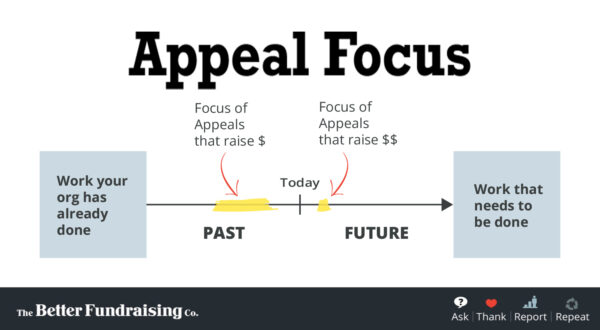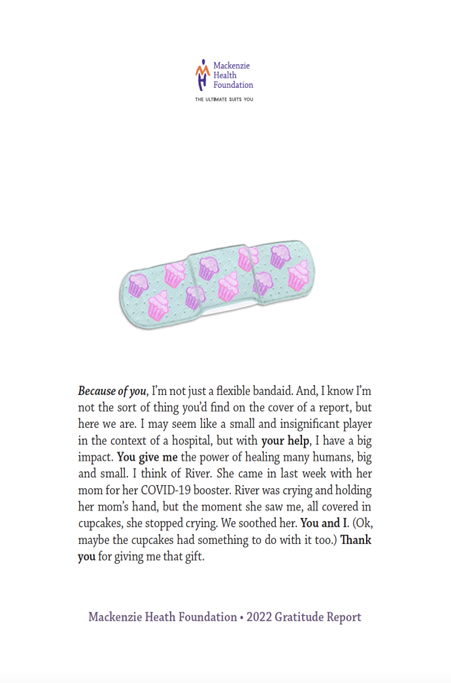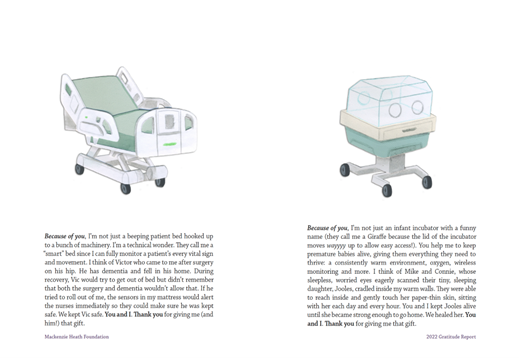My previous post was about why it’s so effective to focus a piece of fundraising on a specific and low-cost part of your nonprofit’s work.
But many organizations don’t believe they have anything specific or low-cost that they can highlight for their donors. They’ll say, “What we do isn’t quantifiable. How can you put a price on inner peace / justice / the environment?”
So today I’d like to give you a few examples of how to identify and price a specific part of your organization’s work – even if your work seems unquantifiable.
(I should mention that I have tried before to write down all the “rules” for how to do this well, and it results in a multi-page document with decision trees that only a deep fundraising nerd would read. And in my experience, what people really want are real-life examples that they can learn from and apply to their own organizations. So here are some examples that show you the process in action.)
I’ve divided the examples into work that is “quantifiable” and “unquantifiable” – though (spoiler alert) you’ll soon see that all nonprofits have work that is quantifiable.
Quantifiable
Say your organization has a goal to protect 150 acres of wetlands this year. And that preserving these wetlands is only part of what your organization does. Let’ see how specific we can get…
- Make a rough determination of the percentage of your total budget that is spent on wetlands preservation. For example, say your total budget is $1.1m, and you spend about 1/3 of your organization’s time and budget on wetlands preservation.
- 1/3 x $1,100,00 = $366,630. That’s how much it costs you to preserve these 150 acres.
- Divide your cost by the number of acres you protect. $366,630 / 150 = $2,444. So, it costs an average of $2,444 to preserve one acre.
- Note: this would make a great major donor offer; “If you give a gift of $2,444 you’ll preserve 1 entire acre of wetlands!”
- There are 4,047 square meters in an acre, so divide the cost per acre by the number of square meters in an acre. $2,444 / 4,047 = 60¢ to protect one square meter.
- This organization now knows that it costs, on average, 60 cents to protect 1 square meter of wetlands.
Now the organization can say things like:
“It costs less than dollar for you to protect a square meter of wetlands. Think of all the flora and fauna you’ll help protect! The square meter you protect might have a bird’s nest, or be part of a stream that’s full of life. A gift of just $49 today will protect an area of wetlands the size of a pickleball court!”
I’m sure you can see how helping a donor think about their gift in that way makes it easier for the donor to envision their impact.
And I’m sure you can see how – at the moment a donor is reading your fundraising and deciding whether to give a gift or not – seeing that their gift of just 60 cents could preserve one beautiful piece of land that they can instantly envision is more likely to give a gift than a donor being asked to support an organization’s wetland preservation programs.
And the process above works for most anything that’s easily quantifiable; the number of people going to a museum in a day, the number of “nights of safety” provided to a victim of domestic violence, the number of words translated by a Bible translator, you get it.
If you don’t know exactly how many acres of wetlands you’re going to protect (or whatever), you can use the number than you plan to do this year to calculate your cost, or you can use your average per-acre cost from last year.
But now… what should you do if what your organization does is not easily quantifiable?
“Unquantifiable”
Many organizations will say something like, “Well, what we do isn’t measurable. You can’t quantify it.”
My response to those organizations is to share my belief that every nonprofit is ultimately made up of specific, understandable actions. Those actions may produce an outcome that is unquantifiable (think “healing” or “inner peace”), but if a nonprofit utilizes any time or money to achieve its goals, there are actions that can be quantified.
So the technique here is to take anything that feels unquantifiable and break it down into smaller, identifiable actions that individual donors will quickly understand.
Here are some examples from my past, along with a couple of “specific, understandable actions”:
Unquantifiable:
- “We provide justice to those who need it”
Quantifiable
- Cost to coordinate the “matching” of an attorney who is donating their time and the person who is receiving legal counsel for free
- This would be the “cost per hour” of the salary of the staff member who does the coordinating, multiplied by the number of hours it costs to match one attorney with a client.
- “Your gift of $37 to CASA provides a person who needs it with an expert attorney they can trust.”
- This would be the “cost per hour” of the salary of the staff member who does the coordinating, multiplied by the number of hours it costs to match one attorney with a client.
- Cost of a legal fee paid for on behalf of a beneficiary
- This would be the cost of the legal fee. (You are free to include the cost per hour of the salary of the staff member who pays the fee.)
- “Sometimes the only thing standing between a person being free of an abusive landlord is a $115 fee, and that’s what your gift will help pay today.”
- This would be the cost of the legal fee. (You are free to include the cost per hour of the salary of the staff member who pays the fee.)
Unquantifiable:
- “We create networks of peacemakers”
Quantifiable:
- Cost per new person added to the network
- This could be the total budget of the organization for a year divided by the number of new people added to the network each year.
- “The cost to add one new peacemaker to our powerful movement is just $90.”
- This could be the total budget of the organization for a year divided by the number of new people added to the network each year.
- Cost for training materials for one person
- This would be the total development and printing costs of the training materials, divided by the number of people who receive them.
- “Just $4 prints and hands our all-important training materials to a new peacemaker so they can have an even greater impact.”
- This would be the total development and printing costs of the training materials, divided by the number of people who receive them.
Unquantifiable:
- “Help people heal at a sacred place”
Quantifiable:
- Cost per visitor
- This could be the total budget of the organization divided by the total number of visitors each year.
- “Your gift of $49 will welcome one person into the sacred land that both you and I love.”
- This could be the total budget of the organization divided by the total number of visitors each year.
- Cost to maintain one acre of the location
- This would be the total maintenance budget, divided by the number of acres.
- “I figured out that it costs an average of $155 to maintain one acre of this special place. Will you give a gift to provide enough maintenance funds to care for at least one acre today?”
- This would be the total maintenance budget, divided by the number of acres.
- Cost to maintain one walking path for one month
- This would be the total amount of time spent maintaining paths, times the cost/hour of the people doing the maintenance, then divided by the number of paths, then divided by 12.
- “Because we boost your gift with volunteer labor, the cost to maintain one of our beloved walking paths is just $75 for a month.”
- This would be the total amount of time spent maintaining paths, times the cost/hour of the people doing the maintenance, then divided by the number of paths, then divided by 12.
I think you see the methodology here. It’s breaking down what you do into easily identifiable steps, then figuring out the cost for that step.
Then, the fundraising shows the donor the value of that step.
To borrow from my previous post, when a nonprofit uses this technique they have “reduced cognitive load for the donor, answered a question donors have (‘how much do I need to give to make a meaningful difference?’), and helped show that anyone can make a difference by giving to the organization.”
All of this works together to make your organization more accessible to more people by making it easier for a person to understand what their gift will accomplish.













